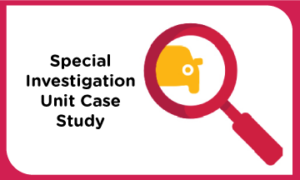According to the National Association of Insurance Commissioners (NAIC), auto theft fraud costs insurance carriers $7.4 billion annually. Both insurance carriers and consumers are impacted by these costs, and Maryland Auto is committed to preventing fraudulent claims. We take insurance fraud seriously and have implemented measures to ensure that payments are made only on legitimate claims. When fraud is suspected, claims are sent to our Special Investigations Unit (SIU) for further examination.
This claim began when our policyholder reported an alleged theft of his insured vehicle. He claimed that the car was stolen from the parking lot of his apartment complex.
The policyholder stated that when he last saw the car, he had parked it in a parking space and locked it. When he returned, the vehicle was missing. The theft was reported to the police, who entered the missing vehicle’s VIN into the National Crime Information Center (NCIC) database.
As a part of the investigation, our claims adjuster had the policyholder send a photograph of both transponder keys, which were still in his possession. The claims adjuster questioned whether a theft could have occurred if the policyholder had all transponder keys. This was the first suspicious loss indicator, or “red flag,” for this claim.
Another suspicious component of this claim was that the policyholder had added comprehensive coverage to the policy three days before the alleged theft occurrence. Without comprehensive coverage, vehicle theft would not be covered by the policy. The adjuster questioned the policyholder about adding this coverage almost a year after purchasing the policy. He answered that he couldn’t afford the coverage at the time of the policy inception but could now afford it. This raised the adjuster’s suspicions further, as the policyholder had stated that he was unemployed at the time of the alleged theft. Adding coverages in the middle of a policy term before a loss occurs is another suspicious loss indicator. With all of these suspicious loss indicators in the claim, the adjuster referred the file to the SIU for further investigation.
The SIU Investigator ran a “tag trace” on the vehicle to determine if the tag had been scanned since the theft, and where. This report found that the license plate was scanned in a different area of Maryland after the theft occurred.
A background search was also completed on the policyholder, showing that he owed nearly $1,000 for an unpaid traffic citation and had filed for bankruptcy in federal court several times, with the most recent filing only five months before the alleged theft.
As a part of the investigation, the SIU Investigator scheduled the policyholder for an Examination Under Oath (EUO). During the examination, the policyholder stated that there wasn’t a loan on the vehicle when he purchased it and that he only purchased liability coverage as he couldn’t afford comprehensive and collision coverages at the time. The policyholder explained the recent purchase of these coverages as an “upgrade in protection” to the original policy. He explained again that he could now afford the additional coverage, even though he was unemployed and had recently filed for bankruptcy.
On the date of the loss, the policyholder explained that he had backed the vehicle into a parking space at his apartment complex, locked the doors, and spent the evening in his apartment, which was out of view of the parking space. He claimed to have possession of both transponder keys in the apartment and that nobody else had access to those keys during this time.
The following day, the policyholder took out the trash, noticed his missing vehicle, and called the police to report the theft. He did not see any glass or debris on the ground. Unfortunately, for the investigation, the parking lot is not under video surveillance.
The policyholder advised the Investigator that he didn’t know where the vehicle could be. When informed that a tag trace showed the car in another area of Maryland, the policyholder denied any connection to that area.
When asked, the policyholder could not explain how the vehicle could have been driven to the other area in Maryland as he had both transponder keys. When Maryland Auto explained that the keys’ microchips were necessary to use the steering column and start the vehicle, he suggested that the car was towed to the other location.
During the SIU investigation, it was discovered that the girlfriend of one of the policyholder’s relatives lives on the same road where the tag trace found the insured vehicle after the theft. Maryland Auto visited this location and found the car parked on the street with the windows slightly ajar. This indicated that whomever had moved the vehicle definitely had the transponder keys, as they are required to activate the electronic windows. Upon inspection of the vehicle, there was no visible body damage, but the ignition lock appeared to have been damaged or removed.
Maryland Auto advised the policyholder that his vehicle had been recovered and was undamaged. It was noted that he was very monotone on the call and specifically asked about the ignition lock. When questioned about how he knew about this damage, he advised that the officer told him about the damage. However, it was later confirmed that the policyholder had not connected with the police officer until after the call from Maryland Auto.
Maryland Auto hired a forensic expert to inspect the vehicle thoroughly. The expert determined that the vehicle lock system and the steering column were not defeated, indicating that the transponder key was definitely used to move the car. He also determined the vehicle had a blown head gasket and that there was water in the oil.
With the damage to the engine, the recent addition of comprehensive coverage, the clear use of transponder key technology to move the vehicle, and the policyholder’s connection to the location where the vehicle was found, and knowledge of ignition lock damage, the suspicious loss indicators on this claim were overwhelming.
Ultimately, the claim was denied for questionable facts and lack of evidence of a theft occurrence. By detecting the signs of a fraudulent claim, the adjuster prevented payment being made on an illegitimate claim.




